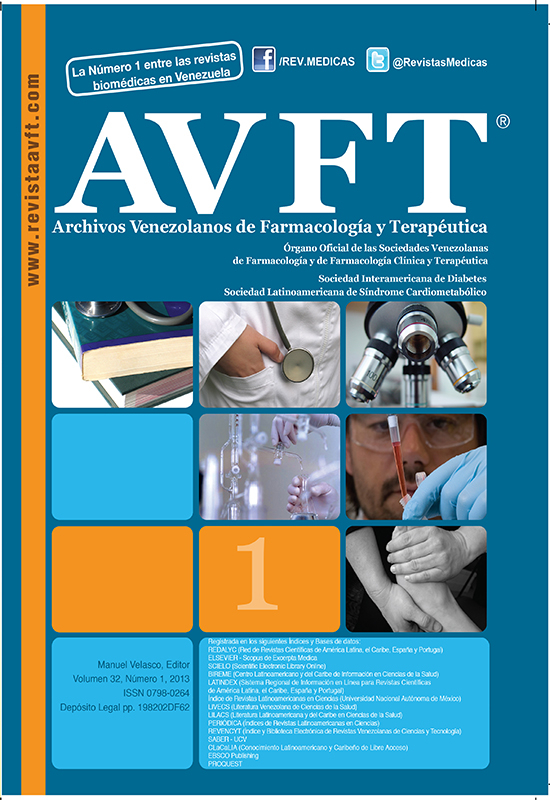Digoxine reduces thermal pain threshold and neuromuscular coordination in rats
Keywords:
Digoxina, Na, K-ATPasa, Umbral del dolor, Hot plate test, Rotarod test Digoxine, K-ATPase, Pain threshold, Rotarod test.Abstract
Es bien conocido que la inhibición de la Na,K-ATPasa por la digoxina induce un incremento en el [Na+]i y [Ca++]i con la consecuente depolarización celular. Este efecto posee una potencial acción en nocicepción. Para analizar este efecto sobre el umbral del dolor y sobre la actividad neuromuscular, se trataron 20 ratas macho adultas Sprague-Dawley (~300g) con NaCl 1mL, 0,9% i.p. (Controles, n=10) o digoxina 1mL, 40 μg.Kg-1.dia-1 i.p. (Digoxina, n=10) por una semana. Diariamente se determinaron el umbral del dolor (hot plate test 50±0,1ºC; media±EEM) y coordinación neuromuscular (rotarod test a 17rpm). La digoxina redujo 28% la latencia del test hot plate (17,16±2,05s) al compararlo con los controles (23,83±2,32s; P<0,001) y redujo la actividad neuromuscular en 95,4% (1,02±5,42s digoxina vs 22,22±5,50s; P<0,001). Ambos efectos se observaron a partir de la primera dosis de digoxina. No se detectó correlación ni entre las latencias del hot plate test y rotarod test ni entre estos valores y la dosis acumulada de digoxina. Estos resultados sugieren un efecto pronociceptivo de la digoxina al reducir el umbral al dolor térmico, efecto que puede ser aún mas intenso que el reportado debido a la acción enmascaradora de la reducción de la actividad motora durante las pruebas conductuales. El presente estudio contribuye a explicar recientes reportes de dolor incrementado en pacientes tratados con digoxina.It is well known that inhibition of Na,K-ATPase by digoxine induces an increased [Na+]i and [Ca++]i with consequent increasedcell depolarization. This effect has a potential implication on nociception. To analyze this digoxine effect on pain threshold and neuromuscular activity, 20 male Sprague-Dawley rats (~300gr) were treated with NaCl 1mL, 0.9% (Controls, n=10) or digoxine 1mL, 40 μg.Kg-1.day-1 (Digoxine, n=10) i.p. for a week. Daily test was performed for pain threshold by hot plate test (50±0.1ºC, mean±SEM) and neuromuscular motor coordination by rotarod test (at 17 rpm). Digoxine reduced 28% the hot plate latency (17.16±2.05s) when compared to controls (23.83±2.32s; P<0,001) and reduces neuromuscular activity in 95.4% (1.02±5.42s digoxine vs 22.22±5.50s; P<0.001). Both effects were observed from the first doses. There was no correlation neither between hotplate and rotarod tests latencies nor between these values and the accumulative doses of digoxine. These results strongly suggest the pronociceptive effect of digoxine by decrease of the thermal pain threshold and that this could be more intense than reported due to the masking effect of a reduced motor activity during behavioral tests. The present results contribute to explain recent report of increased pain in digoxine treated human patients.
Downloads
Download data is not yet available.
Downloads
How to Cite
Castellanos, J., & Eblen-Zajjur, A. (2015). Digoxine reduces thermal pain threshold and neuromuscular coordination in rats. AVFT – Archivos Venezolanos De Farmacología Y Terapéutica, 32(1). Retrieved from http://saber.ucv.ve/ojs/index.php/rev_aavft/article/view/9163
Issue
Section
Artículos




